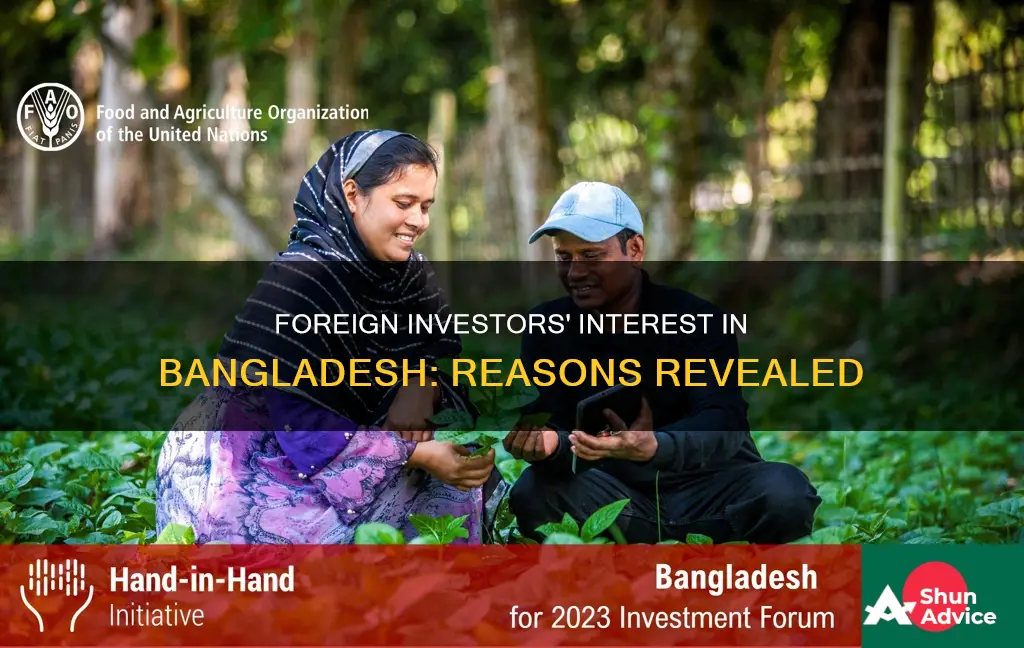
Foreign investors are interested in investing in Bangladesh because of its sustained economic growth over the past decade, its large, young, and hard-working workforce, its strategic location between the large South and Southeast Asian markets, and its vibrant private sector. The Bangladesh government is actively seeking to attract foreign investment, particularly in the areas of energy and infrastructure. The government offers a range of investment incentives under its industrial policy and export-oriented growth strategy with few formal distinctions between foreign and domestic private investors.
| Characteristics | Values |
|---|---|
| Government incentives | The Bangladesh government actively seeks foreign investment, particularly in the areas of energy and infrastructure. |
| Young, hard-working workforce | Bangladesh has a large, young, and hard-working workforce. |
| Strategic location | Bangladesh is situated in the northeastern corner of the Indian subcontinent, sharing a 4,100 km border with India and a 247-kilometer border with Burma. |
| Consistent GDP growth | Bangladesh has enjoyed consistent annual GDP growth of more than six percent over the past decade, with the exception of the COVID-induced economic slowdown in 2020. |
| Strong industries | Bangladesh has strong industries in agribusiness, garment/textiles, leather/leather goods, light manufacturing, power and energy, electronics, light engineering, information and communications technology (ICT), plastic, healthcare, medical equipment, pharmaceutical, ship building, and infrastructure. |
What You'll Learn
- The Bangladesh government actively seeks foreign investment
- Bangladesh has a large, young, and hard-working workforce
- The country has a strategic location between South and Southeast Asian markets
- Bangladesh has a growing consumer base
- The government offers investment incentives and favourable conditions

The Bangladesh government actively seeks foreign investment
The Bangladesh government is particularly keen to attract foreign investment in the areas of energy and infrastructure. Many incentives have been implemented through industrial policy, growth strategy through exports, and a public-private partnership (PPP) program launched in 2009. The government is also seeking to develop certain sectors by granting companies involved in these areas incentives and favourable conditions. For example, the importation of drugs that compete with locally manufactured pharmaceuticals is tightly controlled, and local majority ownership in new shipping companies is required.
Sectors with active investments from overseas include agribusiness, garment/textiles, leather/leather goods, light manufacturing, power and energy, electronics, light engineering, information and communications technology (ICT), plastic, healthcare, medical equipment, pharmaceutical, ship building, and infrastructure. Bangladesh’s Foreign Direct Investment (FDI) stock was $20.87 billion through the end of September 2021, with the United States being the top investing country with $4.1 billion in accumulated investments. Bangladesh received $2.56 billion FDI in 2020, according to data from the United Nations Conference on Trade and Development (UNCTAD).
Although there is little discrimination against foreign investors, the government often favours local industries. For example, the government is seeking to mitigate the risks of being too dependent on industrial production in the textile sector (over 86% of Bangladesh's export earnings come from textiles).
Understanding Investment Interest: Disposal Impact Explained
You may want to see also

Bangladesh has a large, young, and hard-working workforce
Bangladesh's workforce is also strategic, as the country is located between the large South and Southeast Asian markets. This means that the country is well-positioned to take advantage of trade opportunities in both regions.
The country's young population is a key driver of economic growth, as they are more likely to be consumers of goods and services, which in turn drives demand and production. This is reflected in the fact that Bangladesh has a growing consumer base.
The government of Bangladesh actively seeks foreign investment, particularly in the areas of energy and infrastructure. The government offers a range of investment incentives under its industrial policy and export-oriented growth strategy, with few formal distinctions between foreign and domestic private investors.
Maximizing Compound Interest: Strategies for Savvy Investors
You may want to see also

The country has a strategic location between South and Southeast Asian markets
Bangladesh is located in the northeastern corner of the Indian subcontinent, sharing a 4,100-kilometre border with India and a 247-kilometre border with Burma. This strategic location between the large South and Southeast Asian markets makes it an attractive prospect for foreign investors. The country has enjoyed sustained economic growth over the past decade, with a large, young, and hard-working workforce, a growing consumer base, and a vibrant private sector.
Bangladesh's ready-made garment (RMG) industry is a key driver of its economic growth, exporting $35.81 billion of apparel products in the 2021 fiscal year, second only to China. The country also benefits from continued remittance inflows, which reached a record $24.77 billion in 2021.
The Government of Bangladesh (GOB) actively seeks foreign investment, particularly in the areas of agribusiness, garment/textiles, leather/leather goods, light manufacturing, power and energy, electronics, light engineering, information and communications technology (ICT), plastic, healthcare, medical equipment, pharmaceuticals, shipbuilding, and infrastructure. The GOB offers a range of investment incentives under its industrial policy and export-oriented growth strategy, with few formal distinctions between foreign and domestic private investors.
Bangladesh's Foreign Direct Investment (FDI) stock has been growing, reaching $20.87 billion by the end of September 2021, with the United States as the top investing country with $4.1 billion in accumulated investments. While the rate of FDI inflows as a percentage of GDP is one of the lowest in Asia, the country's strategic location and favourable economic conditions make it an attractive destination for foreign investors.
Understanding Compound Interest: Smart Investment Choices
You may want to see also

Bangladesh has a growing consumer base
The country's strategic location between the large South and Southeast Asian markets is also a significant advantage. Bangladesh shares a 4,100-kilometre border with India and a 247-kilometre border with Burma, providing easy access to these neighbouring markets.
Additionally, the Bangladesh government actively seeks foreign investment and offers a range of investment incentives under its industrial policy and export-oriented growth strategy. The government is particularly interested in attracting investment in sectors such as agribusiness, garment/textiles, leather/leather goods, light manufacturing, power and energy, electronics, light engineering, information and communications technology (ICT), plastic, healthcare, medical equipment, pharmaceutical, ship building, and infrastructure.
Despite the country's dependence on the textile sector for a significant portion of its export earnings, the government is taking steps to mitigate this risk by developing other sectors and granting incentives and favourable conditions to companies involved in these areas. This provides foreign investors with opportunities to explore diverse investment avenues in Bangladesh.
The Magic of Compounding: How Interest Grows Investments
You may want to see also

The government offers investment incentives and favourable conditions
The Government of Bangladesh (GOB) actively seeks foreign investment and offers a range of investment incentives under its industrial policy and export-oriented growth strategy. There are few formal distinctions between foreign and domestic private investors. The GOB is particularly interested in attracting foreign investment in the areas of energy and infrastructure, and in developing certain sectors by granting companies involved in these areas with incentives and favourable conditions.
The Bangladesh government is keen to mitigate the risks of being too dependent on industrial production in the textile sector (over 86% of Bangladesh's export earnings come from textiles) by encouraging investment in other sectors.
Bangladesh has enjoyed consistent annual GDP growth of more than six per cent over the past decade, with the exception of the COVID-induced economic slowdown in 2020. This growth has been driven by the ready-made garment (RMG) industry, which exported $35.81 billion of apparel products in the fiscal year (FY) 2021, second only to China.
Bangladesh's Foreign Direct Investment (FDI) stock was $20.87 billion through the end of September 2021, with the United States being the top investing country with $4.1 billion in accumulated investments. Bangladesh received $2.56 billion FDI in 2020, according to data from the United Nations Conference on Trade and Development (UNCTAD).
Investing in a Rising Rate Environment: Strategies for Success
You may want to see also
Frequently asked questions
Bangladesh has a large, young, and hard-working workforce, a strategic location between the large South and Southeast Asian markets, and a vibrant private sector. The country has enjoyed consistent annual GDP growth of more than six percent over the past decade, with the exception of the COVID-induced economic slowdown in 2020.
Foreign investors are interested in a range of sectors, including agribusiness, garment/textiles, leather/leather goods, light manufacturing, power and energy, electronics, light engineering, information and communications technology (ICT), plastic, healthcare, medical equipment, pharmaceutical, ship building, and infrastructure.
The Government of Bangladesh actively seeks foreign investment and offers a range of investment incentives under its industrial policy and export-oriented growth strategy. There are few formal distinctions between foreign and domestic private investors.
Bangladesh’s Foreign Direct Investment (FDI) stock was $20.87 billion through the end of September 2021, with the United States being the top investing country with $4.1 billion in accumulated investments. Bangladesh received $2.56 billion FDI in 2020, according to data from the United Nations Conference on Trade and Development (UNCTAD).







